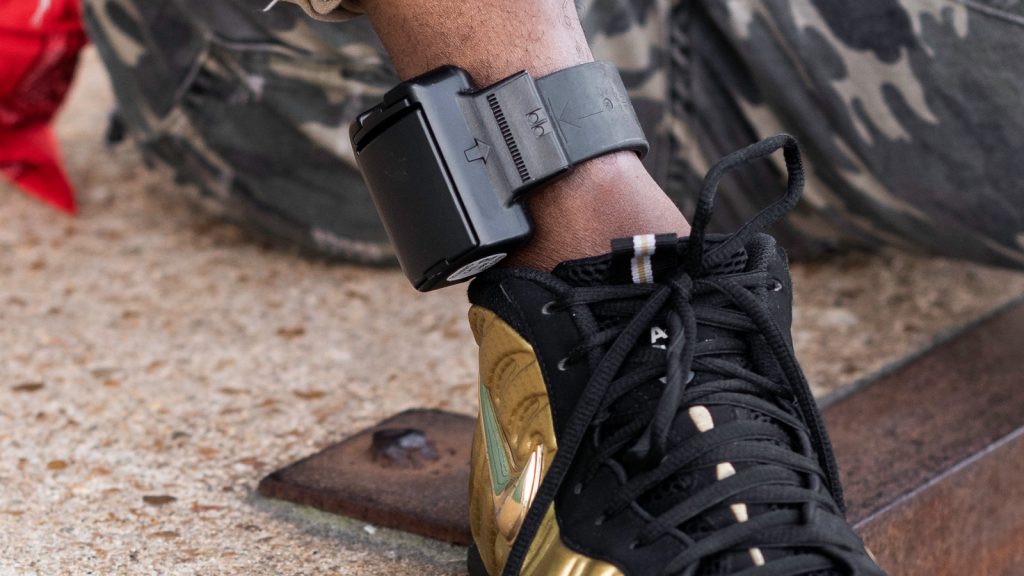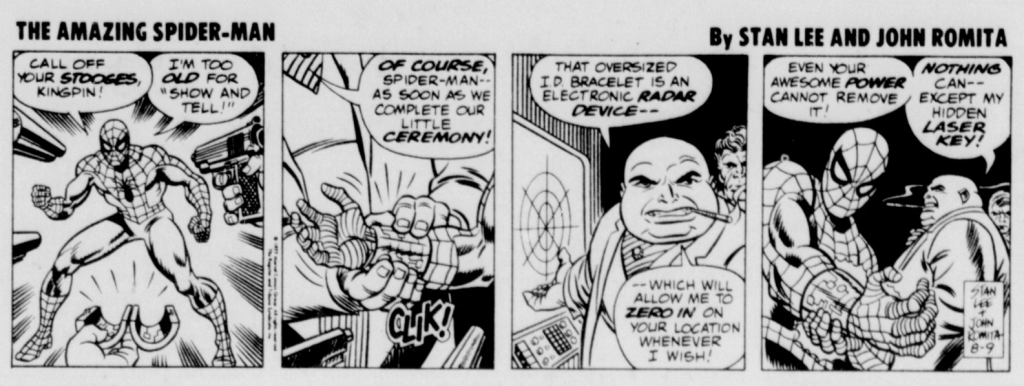How Spider-Man’s Nemesis Aided Real-Life Law Enforcement

For decades, the legal system in the United States and beyond has tried to find ways to keep tabs on those accused of or convicted of low-level crimes without having to put those people behind bars. One common solution is the one seen above (via this New York Times article): the ankle monitor. The device, which the wearer can’t remove without running further afoul of the law, tracks the location of the person to whose ankle it’s attached, and, if the wearer goes somewhere he or she shouldn’t, alerts law enforcement to the infraction. There are roughly 100,000 to 150,0000 such trackers in use in the United States today. They’re controversial — see the above-linked Times article for a deep dive into one major problem — but they’re also increasingly popular in law enforcement circles.
Which is kind of strange, because they were invented by an arch-villain. Kind of.

The man pictured above is Wilson Fisk, better known to comic book fans as Kingpin. He’s a bad guy in the fictional Marvel universe, a nemesis of both Spider-Man and Daredevil. He doesn’t have any superpowers, but he’s definitely an archvillain. He’s a mob boss, leading organized crime down the east coast of the United States, so he has a great deal of influence over people who will hurt you if you threaten him. And he can defend himself as well. According to Marvel Database, a Marvel encyclopedia, his 6’7″, 450-pound frame is “composed almost entirely of muscle that has been developed to enormous size, much like a sumo wrestler, and he possesses peak human strength,” and Fisk “has extraordinary skill in hand-to-hand combat, specializing in a number of martial arts, including sumo wrestling, judo, and hapkido. His fighting skills, strength, and agility make him a match for Spider-Man and Captain America in unarmed combat.” The superheroes of the Marvel universe feared Kingpin, so shouldn’t be surprising that regular law enforcement mostly stayed out of his way.
But in the real world? He doesn’t exist, except for in comic books and now, TV shows (and maybe some upcoming movies). And while comic book judges feared Kingpin, at least one real-life judge admired him, at least for a moment on August 9, 1977.
That day, newspapers across the United States ran the four-panel Amazing Spider-Man strip below. (If you can’t quite read it, click here for a larger version.) It shows Kingpin capturing Spider-Man and, under threat of violence, placing an “oversized I.D. bracelet” around the hero’s wrist. The bracelet, as Kingpin explains, is actually “an electronic radar device” that allows the mob boss “to zero in on your location whenever I wish!” and “even [Spidey’s] awesome power cannot remove it” — to do so, you need a special key that only Kingpin has.

That morning, a man named Jack Love opened his newspaper, read the comic, and had an idea: if Kingpin could use this fictional technology to track Spider-Man, maybe the justice system could find a similar way to track criminals or those out on bail. In most cases, that idea would have simply disappeared as quickly as it emerged, but Jack Love wasn’t just anyone. He was a judge in New Mexico, and one with a passion for criminal justice reform. As Esquire notes, “the comic struck a chord with Love, who saw a potential solution to overcrowded prisons, hoping that electronic monitoring technology could ease the burden on what he called ‘practically intolerable’ jails.” He gave the idea to an engineer named Mike Goss who, in 1983, came up with a solution which he named the Goss-Link. Gizmodo describes how it worked:
The Goss-Link was roughly the size of a pack of cigarettes and communicated with a receiver that was attached to the home telephone. The device sent a signal every 60 seconds to the receiver, which was able to dial a central computer if the device was found to be out of range during one of those pings every minute. In this case, being out of range was roughly 150 feet from your home telephone.
Judge Love tested the device on himself and found it very restrictive; per a newspaper report at the time, “he could not leave his house to do gardening or work in the garage without the device telling on him.” But that, Love figured, was a small price to pay for the upside that the device promised. One of the first people Love tested the device with was a man convicted of writing bad checks but who also had a small child at home; Love used the device to restrict the man to his house from 7 PM to 7 AM, otherwise allowing him to keep his job and take care of his young family. The idea worked, at least in the short term; per Gizmodo, “the unnamed man reportedly finished his 30-day sentence wearing the ankle monitor but was arrested for shoplifting two months later.”
And since then, many other judges and magistrates have used similar devices for similar purposes. All because a really bad guy — fictional, though — used one to try to keep tabs on Spider-Man.
Bonus fact: Today, Marvel movies have a lot of cross-overs — you’ll find a lot of heroes appearing in the titular movies of other heroes. That wasn’t quite the case in 2002 when the Spider-Man trilogy starring Tobey Maguire got its start — but not for lack of trying. In 2000, Hugh Jackman starred as Wolverine in the first X-Men movie, a role he’d reprise another eight or nine times. Jackman’s Wolverine was supposed to also appear in the 2002 Spider-Man movie. As he explained in an interview with HuffPost, he was in New York when they were shooting the movie, and “we really tried to get me to come on and do something, whether it was a gag or just to walk through the shot or something.” But the plan fell apart when Marvel’s producers went to find the Wolverine costume. No one knew where it was, and the scene therefore never came to be.
From the Archives: Blue Ear: The heart-touching story of a superhero made for a specific reader.
